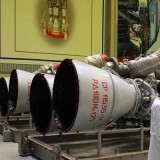Germany’s future IRIS-T Block II air-to-air missile to improve target tracking and accuracy
![]()
{loadposition bannertop}
{loadposition sidebarpub}
As reported by Diehl Defence on January 31, 2025, the German Federal Office of Bundeswehr Equipment, Information Technology, and In-Service Support (BAAINBw) and the company signed a contract at the end of December 2024, for the development and series production of the IRIS-T Block II missile system. The agreement was finalized within a short timeframe through coordination between the IRIS-T Project Management Office (PMO), BAAINBw, and Diehl Defence. Germany is the lead nation in this development program, with Sweden, Spain, and Italy also participating. The BAAINBw signed the contract on behalf of this multinational consortium.Follow Army Recognition on Google News at this link
The new IRIS-T Block II air-to-air missile will receive a new seeker, updated electronics, and a data link capability. (Picture source: Diehl Defence)
In June 2024, the German company Diehl Defence announced that the IRIS-T Block II would incorporate a new seeker, updated electronics, and a data link capability. The German parliament approved financing for this program in December 2024, leading to the contract signing in late December 2024. Diehl Defence has also disclosed details about the IRIS-T SLX air-defense system, designed to engage incoming air-launched weapons and their carrier aircraft. Revealed at the ILA Berlin Air Show in June 2024, this system is expected to intercept targets at distances of up to 50 km and altitudes of up to 30 km. The system is projected to become operational within four years, with the capability to engage cruise missiles and helicopters.
The IRIS-T (InfraRed Imaging System – Tail/Thrust Vector Controlled) is a European short-range air-to-air missile developed in cooperation between Germany, Sweden, Spain, Italy, Greece, and Norway. Since its introduction in 2005, more than 5,000 units have been delivered, and the system is currently in service with the air forces of 13 nations. It is integrated into multiple aircraft platforms, including the Eurofighter Typhoon, Gripen, F-16, Tornado, EF-18, KF-21, and F-5E, and is designed for use against both aircraft and incoming air-to-air and surface-to-air missiles.
The development of the IRIS-T followed Germany’s reunification when Western analysts studied MiG-29A fighters inherited from the former East German Air Force. These aircraft were equipped with the Soviet-designed R-73 air-to-air missile, which surprised experts with its superior maneuverability, off-boresight targeting capabilities, and extended range compared to the AIM-9L/M Sidewinder, the standard missile used by NATO at the time. This led the German Ministry of Defence to study the continued relevance of close-range aerial engagements despite advancements in long-range detection and engagement technologies. Simulations indicated that visual-range combat remained likely due to factors such as the limited identification capabilities of modern aircraft, complex air situations involving multiple national forces, and the necessity of visual confirmation before engagement.
This realization played a critical role in Germany’s decision to withdraw from the AIM-132 ASRAAM program in 1989, as its focus on extended-range engagements was deemed outdated. Instead, Germany sought to develop a missile with superior agility and close-combat capabilities, leading to the IRIS-T program in collaboration with Italy, Sweden, Greece, Canada, and Norway. In April 1996, Bodenseewerk Gerätetechnik (BGT) signed a Memorandum of Understanding (MoU) with these partner nations, with Germany funding 50% of the development costs.
Initial tests were conducted using Sidewinder missiles modified with IRIS-T seekers. The Bundestag approved the project in December 1997, with Germany contributing 46% of the budget, followed by Italy (20%), Sweden (18%), Greece (8%), Canada (4%), and Norway (3%). Spain replaced Canada in the program at the end of 2001, and in 2003, the partner nations signed a procurement contract worth €1 billion. Full-scale production began in the early 2000s, with Germany receiving the first operational missiles in 2005.
The development of the IRIS-T followed Germany’s reunification, when Western analysts studied MiG-29A fighters equipped with the Soviet-designed R-73 air-to-air missile, which were inherited from the former East German Air Force. (Picture source: Russian social media)
Early missiles could only engage targets from the rear, but this changed with the AIM-9L Sidewinder, which introduced all-aspect engagement, allowing it to target threats from multiple angles. The hit probability improved to 73% during the Falklands War but later declined due to the introduction of infrared countermeasures, as seen in the Second Gulf War, where effectiveness fell to 23%. To counter this, modern infrared-guided missiles, including the IRIS-T, use imaging infrared seekers that can differentiate between decoys and actual targets. The IRIS-T also integrates helmet-mounted sighting systems, allowing pilots to designate targets up to 90° off-boresight. Like the Python-5, it has a lock-on-after-launch capability, enabling engagement of targets beyond the aircraft’s immediate field of view. The missile can receive target data via the Multifunctional Information Distribution System (MIDS) and adjust its trajectory accordingly.
Designed for close combat, interception, and self-defense, the IRIS-T is a fire-and-forget short-range air-to-air missile with thrust vector control and an advanced infrared seeker. The seeker combines a focal plane array with a mechanical scan, enhancing resistance to countermeasures such as IR decoys and blinding lasers. The missile’s lock-on-after-launch (LOAL) mode and inertial navigation system allow engagement of targets beyond the seeker’s initial field of view. Moreover, the missile has a squint angle range of ±90° and can engage targets behind the launch platform within 0.5 seconds. Equipped with an 11.4 kg fragmentation warhead triggered by impact or a Ku-band radar proximity fuse and a propulsion system enabling rapid acceleration to speeds up to Mach 3, the IRIS-T is capable of intercepting fast, maneuvering aerial threats, including aircraft and missiles, at ranges of up to 25 km.
Germany remains the primary operator, with an initial order of 1,250 missiles and an additional 1,280 ordered under a framework agreement extending until 2030. Other current operators include Austria (25 missiles), Brazil (unknown number), Greece (350), Italy (444), Norway (150, now transferred to Ukraine), Saudi Arabia (1,400, plus 150 ordered in 2024), South Africa (25), Spain (700), Sweden (450, including the IRIS-T SLS for ground-based air defense), Thailand (220), and Ukraine (unknown number). The missile has been integrated into various aircraft fleets, with five of the seven Eurofighter nations using it. Norway retired its IRIS-T stock in 2022, transferring its missiles to Ukraine. Future operators include Hungary, which is integrating the missile into its JAS 39 Gripen MS20 Block II modernization program, and South Korea, which has tested the IRIS-T on the KF-21 fighter, with a successful test firing announced in May 2024. Romania has also conducted trials with the missile on the IAR-99SM.
Several countries operate or have ordered the ground-based IRIS-T SLM and SLS variants. Sweden has fielded the IRIS-T SLS since 2016, while Germany operates one IRIS-T SLM fire unit, with five more on order and two on option. Ukraine has received four IRIS-T SLM systems and is set to receive additional units, with Norway committing $92 million for a battery. Egypt operates seven IRIS-T SLM systems, with a further order for 400 missiles and 10 IRIS-T SLX systems approved in 2021. Austria, Bulgaria, Estonia, Latvia, the Netherlands, Norway, Slovenia, and Switzerland have placed orders or are negotiating procurement.
This missile is also part of the European Sky Shield Initiative (ESSI), with Germany, Latvia, Estonia, Norway, Belgium, Bulgaria, Czech Republic, Finland, Hungary, Lithuania, Romania, Slovakia, and Slovenia participating. Additionally, the IRIS-T’s cost is lower compared to the PAC-3 MSE (priced at approximately €3.7 million per unit), as Germany is said to pay approximately €400,000 per missile, covering 46% of development costs.
Germany remains the primary operator of the IRIS-T, with an initial order of 1,250 missiles and an additional 1,280 ordered under a framework agreement extending until 2030. (Picture source: Army Recognition)
![]()
{loadposition bannertop}
{loadposition sidebarpub}
As reported by Diehl Defence on January 31, 2025, the German Federal Office of Bundeswehr Equipment, Information Technology, and In-Service Support (BAAINBw) and the company signed a contract at the end of December 2024, for the development and series production of the IRIS-T Block II missile system. The agreement was finalized within a short timeframe through coordination between the IRIS-T Project Management Office (PMO), BAAINBw, and Diehl Defence. Germany is the lead nation in this development program, with Sweden, Spain, and Italy also participating. The BAAINBw signed the contract on behalf of this multinational consortium.
Follow Army Recognition on Google News at this link
The new IRIS-T Block II air-to-air missile will receive a new seeker, updated electronics, and a data link capability. (Picture source: Diehl Defence)
In June 2024, the German company Diehl Defence announced that the IRIS-T Block II would incorporate a new seeker, updated electronics, and a data link capability. The German parliament approved financing for this program in December 2024, leading to the contract signing in late December 2024. Diehl Defence has also disclosed details about the IRIS-T SLX air-defense system, designed to engage incoming air-launched weapons and their carrier aircraft. Revealed at the ILA Berlin Air Show in June 2024, this system is expected to intercept targets at distances of up to 50 km and altitudes of up to 30 km. The system is projected to become operational within four years, with the capability to engage cruise missiles and helicopters.
The IRIS-T (InfraRed Imaging System – Tail/Thrust Vector Controlled) is a European short-range air-to-air missile developed in cooperation between Germany, Sweden, Spain, Italy, Greece, and Norway. Since its introduction in 2005, more than 5,000 units have been delivered, and the system is currently in service with the air forces of 13 nations. It is integrated into multiple aircraft platforms, including the Eurofighter Typhoon, Gripen, F-16, Tornado, EF-18, KF-21, and F-5E, and is designed for use against both aircraft and incoming air-to-air and surface-to-air missiles.
The development of the IRIS-T followed Germany’s reunification when Western analysts studied MiG-29A fighters inherited from the former East German Air Force. These aircraft were equipped with the Soviet-designed R-73 air-to-air missile, which surprised experts with its superior maneuverability, off-boresight targeting capabilities, and extended range compared to the AIM-9L/M Sidewinder, the standard missile used by NATO at the time. This led the German Ministry of Defence to study the continued relevance of close-range aerial engagements despite advancements in long-range detection and engagement technologies. Simulations indicated that visual-range combat remained likely due to factors such as the limited identification capabilities of modern aircraft, complex air situations involving multiple national forces, and the necessity of visual confirmation before engagement.
This realization played a critical role in Germany’s decision to withdraw from the AIM-132 ASRAAM program in 1989, as its focus on extended-range engagements was deemed outdated. Instead, Germany sought to develop a missile with superior agility and close-combat capabilities, leading to the IRIS-T program in collaboration with Italy, Sweden, Greece, Canada, and Norway. In April 1996, Bodenseewerk Gerätetechnik (BGT) signed a Memorandum of Understanding (MoU) with these partner nations, with Germany funding 50% of the development costs.
Initial tests were conducted using Sidewinder missiles modified with IRIS-T seekers. The Bundestag approved the project in December 1997, with Germany contributing 46% of the budget, followed by Italy (20%), Sweden (18%), Greece (8%), Canada (4%), and Norway (3%). Spain replaced Canada in the program at the end of 2001, and in 2003, the partner nations signed a procurement contract worth €1 billion. Full-scale production began in the early 2000s, with Germany receiving the first operational missiles in 2005.
![]()
The development of the IRIS-T followed Germany’s reunification, when Western analysts studied MiG-29A fighters equipped with the Soviet-designed R-73 air-to-air missile, which were inherited from the former East German Air Force. (Picture source: Russian social media)
Early missiles could only engage targets from the rear, but this changed with the AIM-9L Sidewinder, which introduced all-aspect engagement, allowing it to target threats from multiple angles. The hit probability improved to 73% during the Falklands War but later declined due to the introduction of infrared countermeasures, as seen in the Second Gulf War, where effectiveness fell to 23%. To counter this, modern infrared-guided missiles, including the IRIS-T, use imaging infrared seekers that can differentiate between decoys and actual targets. The IRIS-T also integrates helmet-mounted sighting systems, allowing pilots to designate targets up to 90° off-boresight. Like the Python-5, it has a lock-on-after-launch capability, enabling engagement of targets beyond the aircraft’s immediate field of view. The missile can receive target data via the Multifunctional Information Distribution System (MIDS) and adjust its trajectory accordingly.
Designed for close combat, interception, and self-defense, the IRIS-T is a fire-and-forget short-range air-to-air missile with thrust vector control and an advanced infrared seeker. The seeker combines a focal plane array with a mechanical scan, enhancing resistance to countermeasures such as IR decoys and blinding lasers. The missile’s lock-on-after-launch (LOAL) mode and inertial navigation system allow engagement of targets beyond the seeker’s initial field of view. Moreover, the missile has a squint angle range of ±90° and can engage targets behind the launch platform within 0.5 seconds. Equipped with an 11.4 kg fragmentation warhead triggered by impact or a Ku-band radar proximity fuse and a propulsion system enabling rapid acceleration to speeds up to Mach 3, the IRIS-T is capable of intercepting fast, maneuvering aerial threats, including aircraft and missiles, at ranges of up to 25 km.
Germany remains the primary operator, with an initial order of 1,250 missiles and an additional 1,280 ordered under a framework agreement extending until 2030. Other current operators include Austria (25 missiles), Brazil (unknown number), Greece (350), Italy (444), Norway (150, now transferred to Ukraine), Saudi Arabia (1,400, plus 150 ordered in 2024), South Africa (25), Spain (700), Sweden (450, including the IRIS-T SLS for ground-based air defense), Thailand (220), and Ukraine (unknown number). The missile has been integrated into various aircraft fleets, with five of the seven Eurofighter nations using it. Norway retired its IRIS-T stock in 2022, transferring its missiles to Ukraine. Future operators include Hungary, which is integrating the missile into its JAS 39 Gripen MS20 Block II modernization program, and South Korea, which has tested the IRIS-T on the KF-21 fighter, with a successful test firing announced in May 2024. Romania has also conducted trials with the missile on the IAR-99SM.
Several countries operate or have ordered the ground-based IRIS-T SLM and SLS variants. Sweden has fielded the IRIS-T SLS since 2016, while Germany operates one IRIS-T SLM fire unit, with five more on order and two on option. Ukraine has received four IRIS-T SLM systems and is set to receive additional units, with Norway committing $92 million for a battery. Egypt operates seven IRIS-T SLM systems, with a further order for 400 missiles and 10 IRIS-T SLX systems approved in 2021. Austria, Bulgaria, Estonia, Latvia, the Netherlands, Norway, Slovenia, and Switzerland have placed orders or are negotiating procurement.
This missile is also part of the European Sky Shield Initiative (ESSI), with Germany, Latvia, Estonia, Norway, Belgium, Bulgaria, Czech Republic, Finland, Hungary, Lithuania, Romania, Slovakia, and Slovenia participating. Additionally, the IRIS-T’s cost is lower compared to the PAC-3 MSE (priced at approximately €3.7 million per unit), as Germany is said to pay approximately €400,000 per missile, covering 46% of development costs.
![]()
Germany remains the primary operator of the IRIS-T, with an initial order of 1,250 missiles and an additional 1,280 ordered under a framework agreement extending until 2030. (Picture source: Army Recognition)




